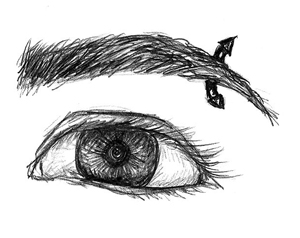
Whether it be knuckles, hand webbing, hip, neck, navel, sternum, nostril, chin, ear, genitalia or lips, the body is a piercing paradise.
Be they subtle or conspicuous, piercings have always been a form of body art, whether symbolic or sporadic.
Some piercings have taken precedence over others. The traditional earlobe piercing has become routine and others have risen in popularity.
Daniel Kicinski, a piercing and scarification artist at Binghamton’s The Shaman’s Den, said the profession sees phases in what customers request.
‘Right now the nostril is popular, the tongue is fading away,’ he said.
People are getting pierced in more unconventional places. Surface piercings, which pass through a flat flap of skin instead of puncturing through an entire piece of body tissue, have greatly increased the variety of piercings available. Nape, navel and eyebrow surface piercings have also become increasingly popular.
‘Surface piercings, such as those on the sternum, right in the middle of chest, used to be thought of as taboo,’ Kicinski said. ‘People said they won’t heal correctly, but new jewelry advances allow that to heal better.’
A majority of the piercer’s customers are around 19 to 25 years old; however, 16-year-old teenagers who have a parent available, and even 70-year-olds, also come to get pierced, he said.
Why have piercings become so popular?
‘People get piercings for four reasons: aesthetics, shock value, spiritual (because it means a lot to them) and sexual,’ Kicinski said.
Puja Kenia, a freshman business major, said she recently pierced her navel because she could.
‘I was 18 and at college and away from parents. I was exerting my independence,’ she said.
One Binghamton University student received a nipple piercing because it was something she had always wanted. It was not visible and it acted as a personal statement for herself. ‘It defines something about you,’ she said.
English professor Joseph Church, who is teaching a course on symbolism in popular culture, suggests that people get pierced because there is a ‘sense of alienation in this world.’
‘A lot of people have a feeling of being unreal, ghost-like in a way,’ he said.
He suggests getting pierced is a manner of feeling human.
‘People seem interested in driving metal into your body because it’s your body and it’s real,’ he said.
Church added that American culture is formed by manufactured images and that piercings provide a means of establishing our individuality.
‘You’re there and seen by other people,’ Church said. ‘It affects other people, too. People perceive you, notice you.’
Following Church’s theory, Kicinski described the shock value of piercings: creating a reaction in others.
Church said prisoners get tattoos because, while they are in prison, it’s the only thing that belongs to them.
‘It’s their body, it’s free, it’s theirs,’ he said.
Kicinski, who has his ears stretched out to seven-eighths of an inch and septum, tongue, labret, nipple and navel piercings, also gives a reason for getting pierced.
‘I’m vain, I like the way they look,’ he said.


